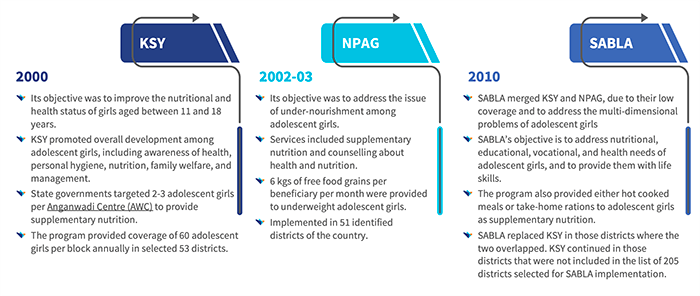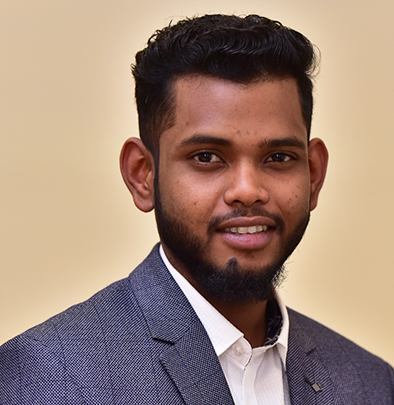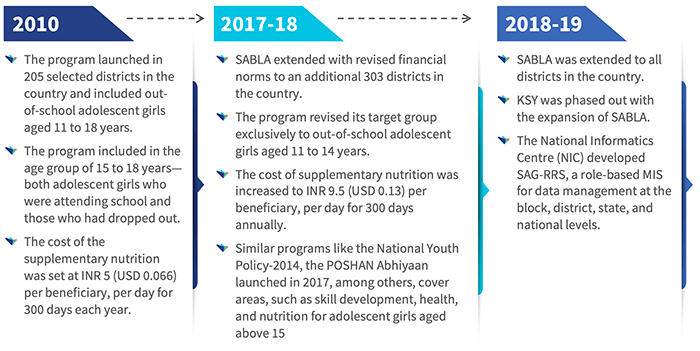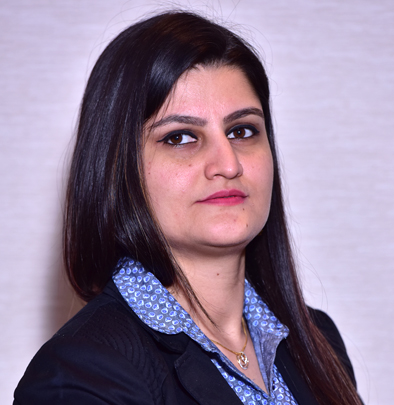Taking the well-designed SABLA scheme to the next level (Part-I)
by Diganta Nayak and Prairna Koul
May 17, 2021
4 min
For the 111 million girls in India aged 11-18, adolescence is particularly challenging due to poor access to healthcare, education, skill development, nutrition, employment opportunities, hygiene, and sanitation.
Our blog examines the origin and evolution of SABLA, an initiative of the government to address these challenges.
“Adolescence represents an inner emotional upheaval, a struggle between the eternal human wish to cling to the past and the equally powerful wish to get on with the future.”- Louise J. Kaplan, Psychologist and author
Adolescents around the world face a growing number of physical and emotional challenges that often leave them vulnerable as they embark on their life’s trajectory. India is home to the world’s largest adolescent population—nearly 232 million or 22.8% of the country’s population are between 11-18 years. Adolescent girls in the country constitute nearly 111 million from this age group.
In this first part of our two-part blog series on India’s Scheme for Adolescent Girls (SABLA), we look at the origins of the scheme. We also examine how, in its current incarnation, SABLA works to offer an integrated package of services to adolescent girls for self-development and empowerment.
Adolescence is a period of rapid development. It has a long-term impact on the health and well-being of girls. Adolescent girls need education regarding menstrual hygiene, reproductive and sexual health, nutrition, and health issues, particularly those related to iron deficiencies.[1] For girls in India, adolescence is particularly challenging—besides dealing with the usual tumult that comes from these growing years, adolescent girls have to grapple with poor access to healthcare, education, skills development, nutrition, employment opportunities, hygiene, and sanitation. Besides, they are always at risk of being married young and becoming pregnant.[2],[3]
To address the challenges that adolescent girls face in India, the Government of India (GoI) has designed and implemented several Centrally Sponsored Schemes (CSS)[4] and other programs. These include Kishori Shakti Yojana (KSY), the Nutrition Program for Adolescent Girls (NPAG), and SABLA, all of which utilize the Integrated Child and Development Services (ICDS) infrastructure to deliver associated services. [5] SABLA combines the erstwhile KSY and NPAG to address the issues that adolescent girls face. Below is a brief overview of these initiatives with timelines of their evolution.

SABLA was implemented in three phases as follows:
SABLA provides nutritional supplements, health check-ups, and access to education, among other services to adolescent girls.
The services offered under the program converge with various programs administered by the health, education, youth, labor, and employment departments of the GoI as explained below.[6]
- Convergence with health systems: The Health Department provides iron and folic acid (IFA) supplements, nutrition and health education, health check-ups, and referral services using the ICDS infrastructure. The IFA tablets are distributed at the AWCs. Anganwadi Workers (AWW) provide adolescent girls information on food fortification, dietary diversification, advantages of IFA supplements, and education on sanitation and personal hygiene.[7] The AWCs organize health check-ups Kishori Diwas[8]to ensure adolescent girls can access health services.
- Convergence with the education system: The Education Department helps to bring out-of-school adolescent girls into the mainstream formal education system. The department helps adolescent girls gain access to schooling through various programs, including Sarva Siksha Abhiyaan, Kasturba Gandhi Balika Vidyalaya, and the Adolescent Education Programme. In school, adolescent girls receive Hot cooked meals (HCM)under the Mid-Day Meal scheme to supplement their daily nutritional requirements. If the provision for HCM is not available, adolescent girls are provided with take-home ration (THR).
- Convergence with the Department of Youth Affairs: The Department of Youth Affairs organizes sessions on life skills, nutrition, and health. Multiple and diverse opportunities strengthen life skills among adolescent girls. These opportunities include cultural activities, social networks, civic action, health, and sports for development. Awareness talks and exposure visits are arranged in collaboration with police personnel, bank officials, postal departments, and health functionaries to make adolescent girls aware of existing public services and their accessibility.
- Convergence with the Department of Labour and Employment (DLE): The DLE organizes vocational training courses under various national skill development programs.
AWW, along with schoolteachers and the school management committees, undertake home visits to identify out of school girls in the age group of 11 to 14 years. To enroll beneficiaries, the personal details, including Aadhaar number, are collected and maintained at the AWC. To monitor scheme implementation and progress, Kishori health cards are issued to all registered adolescent girls. The AWW records the health and nutrition status of adolescent girls on these cards periodically.
Since 2019, the web portal SAG-RRS has been recording all beneficiary details digitally. According to the website, the SABLA has been implemented in 553 districts out of 728 total districts in India. The scheme follows a five-tier monitoring structure with a monitoring committee at the national level, followed by state, district, project, and village levels.
SABLA has evolved over the years to cater to the needs of adolescent girls better. However, areas of continuing concern persist around non-achievement of targets and difference in performance among states. The next blog in this series will discuss the challenges in implementation and recommendations to make SABLA more effective and impactful.
[1] Health needs of adolescent girls living in an urban slum of a metropolitan city, JFMPC
[2] Addressing comprehensive needs of adolescent girls in India, ICRW
[4] CSS are programs implemented by state governments, but are largely funded by the central government with a defined share that the respective state government’s contribute.
[5] Adolescent Girls, UP, CAG
[6] Administrative guidelines, Scheme for Adolescent Girls
[7] The Anganwadi workers are women selected from within the communities by committees at the project level. They receive a monthly honorarium from the government for their service to the community.
[8] Kishori means “adolescent girl.” The Kishori Diwas is a special day that falls once every three months when are medical officers or ANMs conduct general health check-ups of adolescent girls. The Education and Communication (IEC) committee utilizes this day to inform communities, parents, and siblings, and to motivate girls to attend school.
Written by

 by
by  May 17, 2021
May 17, 2021 4 min
4 min 


Leave comments